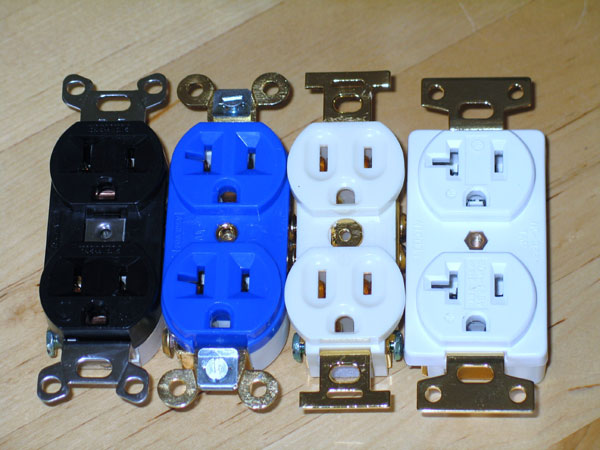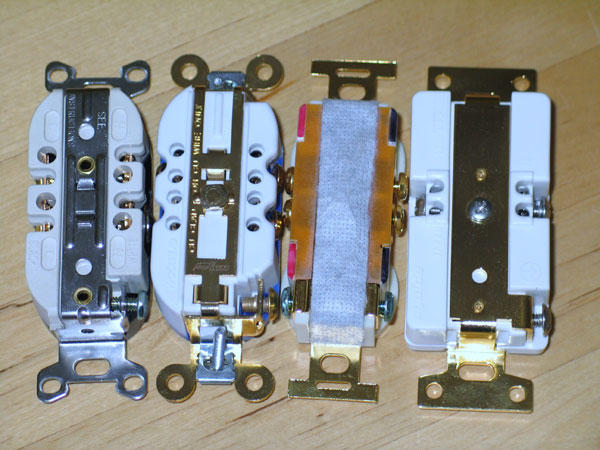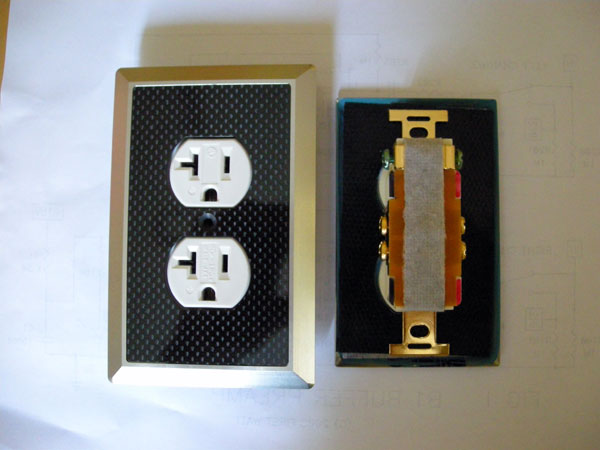![[SoundStage!]](../sslogo3.gif) D-I-Why & How D-I-Why & HowBack-Issue Article |
|||||||
September 2008 Plugapalooza!: Audio-Grade AC Outlets from First Impression Music, Furutech and Oyaide Try as I might, I can’t get permission to rip open my listening room’s walls to run dedicated power lines for my audio system. A person who shall go unnamed and to whom I'm married doesn’t see the need for such a project. I have to admit, though, that doing it right would be a big and costly job: I reckon at least $10,000 for audio-grade mains cable and a gold-plated copper breaker panel. But if I spent that kind of money on audio, my head would quickly be on a platter. Happily, there is an excellent -- and far less expensive -- means of improving the electrical feed to any audio system: audio-grade AC outlets.
There are a couple of key features that differentiate audio-grade outlets from the more pedestrian variants scattered about our homes. Audio-grade outlets are designed to achieve a terrific grip on the plug tines inserted into them, ensuring that there’s greater contact area between the female outlet and male connector. A larger contact area should, in theory, provide a less resistive path for electron flow. Better contact also reduces micro-arcing, which is electricity’s tendency to jump from one surface to another. This phenomenon creates electrical noise, so reducing it can only result in a noticeably quieter audio system. Regular, industrial and hospital-grade outlets generally feature brass contacts for the hot and neutral connections and sometimes nothing more than steel for the ground connection. Audio outlets, on the other hand, tend to utilize highly conductive copper contacts and often feature one or more outer layers of precious-metal plating to shield the substrate from the oxidizing effects of air.
Upgrading to an audio-grade outlet is much easier than you might think -- so easy, in fact, that I did it four times in a row! No, I'm not into redundancy, but I am into high-performance audio, so I’ll not only discuss the steps involved in upgrading an outlet, I’ll share some thoughts on four audio-grade outlets from three of the top names in the field: First Impression Music’s (FIM) 880GP ($75) and 888 ($130) Oyaide’s R-1 ($130) and Furutech’s FP-15A (Cu) N ($55). Removal and installation Boilerplate warning and disclaimer: Do not attempt to install your own electrical outlets unless you’re comfortable doing so and you’ve taken proper safety precautions -- like turning off your power. When in doubt, hire an electrician. There is more than enough current in the average home electrical circuit to kill, and we at SoundStage! will accept no responsibility for your demise. Removing a standard electrical outlet and replacing it with an audio-grade version is fairly straightforward. For the sake of brevity, we’ll assume that you’ve turned off the power to the outlet in question and have removed the faceplate and the screws which hold the outlet to the wall box. The existing outlet has to be pulled free of the wall, but just far enough to facilitate easy access to the side-mounted screws that secure the wires to the outlet. With the outlet in the open, you’ll see that there are (or should be) three wires attached to it: one white (neutral), one black (hot) and one green or bare copper (ground). To remove these from the outlet, simply loosen the screws on each side. If the wires are bent around the screw shafts they may take a little convincing before they finally come free. Before securing the wire to the new outlet, it’s a good idea to clean up the ends and expose fresh copper. A piece of fine garnet sandpaper will do a nice job of it. Chemical cleaners can work well, but they will take longer to work and can leave a residue on the wire. If the ground wire is uninsulated, don’t try and clean up the whole length; just the final quarter inch will do. Avoid touching the cleaned ends with your fingers as skin oils and acids will induce the copper to re-oxidize. At this point you’re ready to install the new, high-performance audio-grade outlet. You remove it from its fancy packaging, admire its lovely face and then flip it over to see…nothing. Where are the markings to tell you which wire connects to which screw? It was a surprise to see that none of the four audio-grade outlets seems to follow any kind of standard marking scheme. Neither of the FIM receptacles have any markings to indicate which side is for the hot wire and which is for neutral. The Oyaide R-1 shows an N for the neutral side and a ground (earth) symbol for that connection. You can deduce which is the hot connection. Furutech provides the most thorough markings. Not only are all poles marked (with L, N and E for hot, neutral and ground), but the screws are colored to correspond with the wire that connects to them. Of course, it should be plainly obvious that the new outlet will be wired just as its predecessor was, but there’s nothing like a little extra reassurance in the form of markings to let the DIYer know that he has it right. Well done, Furutech, for understanding that. All but the FIM 888 have round holes through which the wires connect. These little openings are the single greatest innovation in outlet design -- ever. What makes them so special is that they allow the installer to insert a straight wire end directly into the outlet’s clamping mechanism, eliminating the need to coerce a hooked wire around the outlet’s side screws. If your wire ends are already hooked, straighten them and use the holes: you’ll save a lot of time and spare yourself some frustration. The hole-free 888 isn’t at too great a disadvantage here. Unlike the other outlets, its side screws aren’t recessed -- they stand proud of the outlet, making it much easier to hook the wire around them. Whichever method is used to attach the wire, the side screw is still responsible for securing it to the outlet. But take care when tightening the screws; they are often made of the same soft copper as the outlet’s contacts and may strip if over-torqued. Once the wires are securely fastened to the new outlet, push it back into the wall box and secure it in place with the appropriate screws. Congratulations -- you did it! All that’s left to do is to turn on the power and enjoy the sonic fruits of your labor. What does electricity sound like? All right, now you know how to install an audio-grade outlet. But is doing so a worthwhile endeavor? And how do these outlets sound in comparison to an old favorite, the hospital-grade Pass and Seymour 8200H?
As inelegant as it sounds, each of the audio-grade outlets was given 100 hours of break-in time before any critical listening. All, in turn, powered my reference Simaudio Moon i5.3 integrated amplifier via a Furutech FP-3TS862 power cord fitted with Furutech’s FI-25(R) and FI-25M(R) connectors. My DIY power filter was connected to the outlet’s second socket with a Supra LoRad power cord terminated with Oyaide’s P-004 and C-004 connectors. The power filter feeds everything in my system save the i5.3. Across the board, each of these outlets offered very noticeable improvement in bass definition, detail retrieval , instrumental layering, and soundstage width and depth. Fascinatingly, each successive outlet, from least to most expensive, managed to redefine silence, as backgrounds grew ever darker, until at the end I began to wonder if a black hole might be forming in my wall. Each outlet grabbed onto male AC connectors like a hungry lion on a wildebeest. And where these outlets differed, it was in the degree of sonic improvement that each offered versus the competition. Although it’s certainly not always the case in audio, when it comes to high-end AC outlets I have surveyed, price definitely correlates to performance. It doesn’t cost much more than the $38 Pass & Seymour outlet, but Furutech’s FP-15A (Cu) N1 is definitely a higher-spec part. The Furutech is the only non-copper-based outlet in this roundup, and instead features demagnetized and cryo-treated phosphor-bronze contacts. These are plated in cuprum, which my dictionary tells me is Latin for "copper." The outlet’s body is quite impressive for its high-quality appearance and is said to be composed of nylon and glass fiber, with a polycarbonate black face. Compared with the 8200H, the FP-15A (Cu) sounds considerably more musical -- involving and tubelike. It drew me into the music with a slightly warm midrange and an open, airy and soft (but not dull) treble. Detail retrieval was significantly improved by the FP-15A, probably because the background seemed a lot blacker as compared to the hospital-grade outlet. I also heard an across-the-board improvement in ambience cues, which made recordings more involving and interesting. The FIM Model 880GP is a 20-amp-rated outlet that, in its latest version, features 24k gold-plated-copper contacts. FIM says that the outlet’s housing is made from ceramic and is designed for minimal resonance and high rigidity. The 880GP can accept up to four leads of 8-gauge wire and is made to be an ideal partner for amplifiers and other high-current devices. As would be expected of an audiophile-grade receptacle, the 880GP features very strong grip pressure. The 880GP has a sound that is quite distinctive. The two most immediately noticeable improvements over the Furutech outlet were tighter bass and an even darker background. In fact, the 880GP startled me on more than one occasion as it permitted instruments to leap out of a black silence and explode into existence. Detail retrieval was excellent with the 880GP and represented a clear improvement over the resolving ability of the Furutech. Treble was on the sweet, delicate side, which was very refreshing. The 888 is made for FIM in Japan by National, known to us in the west as Panasonic. The 888 is very different in appearance than the 880GP and, with its ivory color, could easily be mistaken for an average outlet until you take a closer look. The 15-amp-rated 888 has a heavy, high-density plastic housing and features 24k gold-plated-copper contacts. FIM’s top-of-the-line outlet is also equipped with a material that absorbs electromagnetic interference (EMI). It covers the ground strap along the back of the outlet. The 888 has the strongest grip of any outlet I’ve ever tried. Everything I plugged into the 888 was held with the sort of grip that a person might use to hold a jackpot-winning lottery ticket. Performance-wise, the 888 was clearly a member of the 880GP’s family, but the 888 is the cousin who got a Ph.D, has a supermodel wife and drives a Ferrari. Wherever the 880GP was very good, the 888 was excellent. Attack was sharp, and decaying notes on cymbals, piano, cello and guitar seemed to hang in the air forever. The improvement in micro detail retrieval was startling. The FIM Model 888 is an outstanding outlet that isn’t likely to disappoint. It has a stupendous grip, offers stunning performance and is easy to recommend. Oyaide’s R-1 is the company’s newest and top AC outlet and is rated at 20 amps. It features contacts made of beryllium copper, a stronger form of the metal that Oyaide says will ensure that the R-1’s contacts maintain their firm grip over the long term. The contacts are machined from billet stock and are hand polished -- twice -- to achieve a surface that is as smooth and as flat as possible. Following the final polish, the contacts are plated with platinum and palladium. The R-1’s metal parts also undergo deep cryogenic treatment, which is said to further enhance their conductivity.
The R-1 is physically larger than the other outlets, though I had no trouble fitting it into a standard single-outlet wall box. The R-1's housing is made from what are described as high-tech composite plastics. Like the other outlets, the R-1 feels quite solid and inert in hand and appears to be well damped against vibration. The R-1 grips male AC plugs in a most reassuring way, and it seems unlikely that any power cord plugged into an R-1 could come out accidentally. Interestingly, the R-1 mated better with the Oyaide P-004 male connector than the Furutech FI-25M(R). The P-004, which undergoes the same polishing and plating process as the R-1, actually seemed to snap into the outlet, leaving no gap between the P-004’s housing and the outlet. If I had to, it wouldn’t be easy to pick out a winner between the R-1 and FIM 888 based on detail retrieval, attack and decay, as both provide terrific and similar performance in these categories. When it came to conveying the emotional content of music, however, in my system the R-1 had the edge. The midrange was the slightest bit forward, but in a most pleasant, tubelike fashion. Vocalists in particular were given their full due, up front and central to the performance but not overly spotlit. The R-1's treble was clean and clear but a little bit recessed. The R-1 certainly earns its place atop Oyaide’s lineup of AC outlets. It's simply terrific. Conclusion In a world of sometimes dubious and almost always pricey audio tweaks, audio-grade outlets are the real deal and represent excellent value. Any and all of these outlets are heartily recommended. So cut the power, grab a screw driver and get DIYing! ...Colin Smith
|
|||||||
|
|||||||
![[SoundStage!]](../sslogo3.gif) All Contents All ContentsCopyright © 2008 SoundStage! All Rights Reserved |


